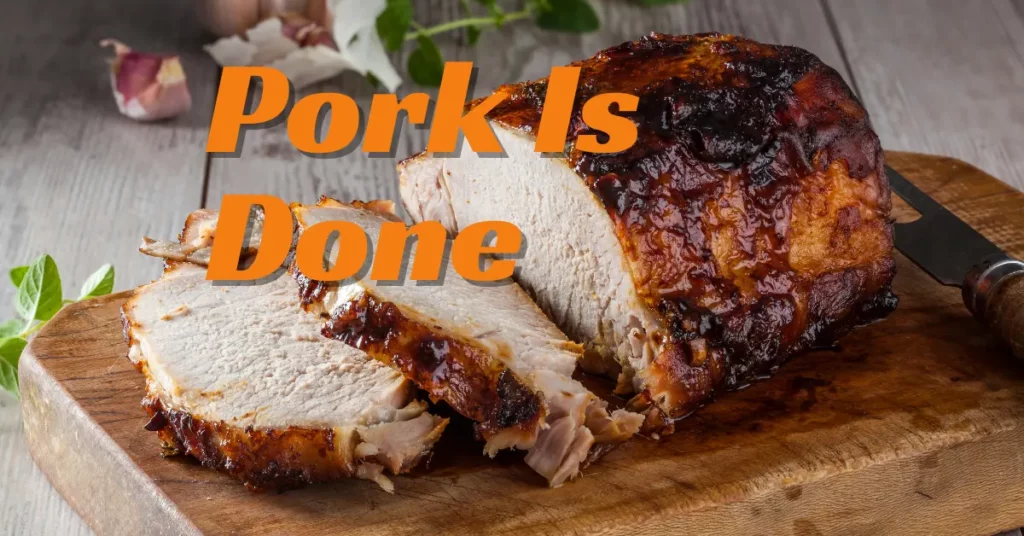This post may contain affiliate links. If you use these links to buy something we may earn a small commission. Thanks.
Cooking pork to the right doneness is essential for both safety and flavor. Undercooked pork can pose health risks, while overcooked pork turns dry and tough. Whether you’re preparing pork chops, tenderloin, ribs, or ground pork, knowing the right methods to check doneness ensures a juicy, delicious meal every time.
In this guide, we’ll cover the USDA’s recommended internal temperatures, visual and texture cues, the best way to use a meat thermometer, and common mistakes to avoid.
USDA Recommended Internal Temperature
To eliminate the risk of foodborne illnesses like trichinosis while preserving flavor and moisture, the USDA has set specific internal temperature guidelines for pork:
- Whole cuts (pork chops, loin, roasts): 145°F (63°C), followed by a 3-minute rest
- Ground pork: 160°F (71°C)
- Precooked ham: 140°F (60°C)
- Ribs and tougher cuts: These are often cooked to higher temperatures (190-205°F) for tenderness
Using a meat thermometer is the most reliable way to ensure pork reaches the correct temperature without overcooking.

Visual Cues to Check Doneness
While temperature is the most accurate method, you can also use visual signs to determine if pork is done:
1. Slightly Pink Center is Safe for Whole Cuts
A common misconception is that pork must be fully white to be safe. In reality, modern pork is safe to eat with a slightly pink center, as long as it has reached 145°F. Overcooking to remove all pinkness will result in dry meat.
2. Clear or Slightly Pink Juices
When you cut into the thickest part of the pork, the juices should be clear or have a faint pink hue. If they appear red or bloody, it likely needs more cooking.
3. Firm but Slightly Springy Texture
Properly cooked pork should feel firm when pressed but still have a slight bounce. If it is mushy, it may still be raw; if it’s very tough, it’s likely overcooked.
Using a Meat Thermometer: The Most Reliable Method
A digital meat thermometer is the best way to guarantee perfect doneness. Follow these steps to get an accurate reading:
1. Insert the Thermometer Properly
- Place the thermometer into the thickest part of the pork (avoid fat and bone).
- For thin cuts like chops, insert from the side rather than the top.
2. Wait for a Stable Reading
- Most thermometers will provide a reading within a few seconds.
- Ensure the temperature remains steady before removing the thermometer.
3. Check Different Parts for Large Cuts
- If cooking a large roast or thick pork cut, check the temperature in multiple spots to ensure even doneness.
Other Testing Methods (Less Reliable but Useful in a Pinch)
1. The Touch Test
The texture of pork can indicate doneness:
- Raw pork feels soft and spongy.
- Medium-cooked pork (145°F) has a slight firmness but is not stiff.
- Overcooked pork feels very firm and dry.
For a comparison, press the fleshy part of your palm under your thumb:
- When relaxed, it mimics raw pork.
- When slightly clenched, it mimics medium doneness.
- When tightly clenched, it mimics overcooked pork.
2. The Juice Test
Cut into the thickest part of the pork and observe the juices:
- Clear or light pink juices indicate doneness.
- Red or dark pink juices suggest it needs more time.
3. The Color Check
Properly cooked pork is light pink to white but should never be gray or dry.
Resting the Pork After Cooking
After reaching the correct temperature, it’s crucial to let pork rest for at least 3-5 minutes before cutting.
Why Resting Matters:
- The internal temperature continues to rise by about 5°F due to carryover cooking.
- It allows juices to redistribute, making the pork juicier and more flavorful.
- Cutting too soon causes juices to escape, resulting in dryness.
Common Mistakes to Avoid
To ensure a perfect pork dish, steer clear of these common mistakes:
1. Overcooking Pork
Many people overcook pork out of fear of undercooking. However, cooking past 145°F (for whole cuts) or 160°F (for ground pork) can dry it out.
2. Not Using a Thermometer
Relying on color alone can be misleading. Some pork appears fully cooked even when underdone, while others retain pink hues even when safe. Always use a meat thermometer for accuracy.
3. Cutting Too Soon
If you slice into pork immediately after cooking, the juices will run out, leaving dry meat. Always let it rest!
4. Cooking on Too High or Too Low Heat
- High heat: Can cause the outside to burn while the inside remains raw.
- Low heat: Can make the meat dry and tough if cooked too long.
- Best method: Use medium to medium-high heat for even cooking.
5. Ignoring Carryover Cooking
Removing pork from heat at the exact temperature can lead to overcooking as the internal heat continues to rise. Instead, pull it 5°F before the target temperature to account for carryover cooking.
Conclusion
Cooking pork correctly is about balance ensuring it’s safe to eat while keeping it tender and juicy. The best way to check doneness is by using a meat thermometer and aiming for 145°F for whole cuts and 160°F for ground pork. Visual and texture cues, like a slightly pink center, clear juices, and firm texture, can also help.
Avoid common mistakes like overcooking, skipping resting time, or cutting too soon. By following these tips, you’ll always have perfectly cooked, flavorful pork on your plate!
